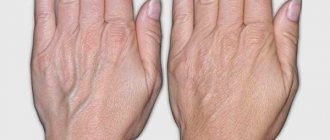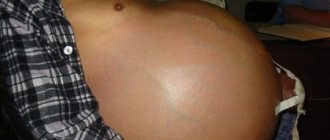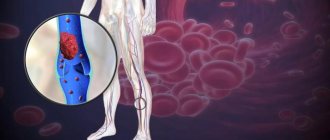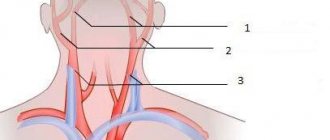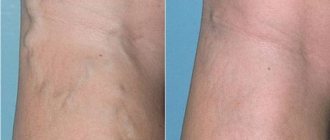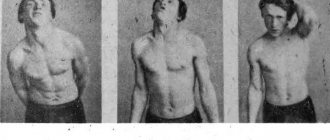Phlebitis of the veins on the arm after a catheter and injections
Phlebitis on the arm after a catheter is an inflammatory process; it is localized on the walls of the veins as a result of their traumatic effects during the treatment of a certain disease. If this condition is not treated, then after some time the damaged vessels will begin to collapse. So, what is phlebitis, why the veins become inflamed and what therapeutic measures are used in this case.
Principles of post-injection phlebitis
Phlebitis that occurs after an IV drip has several varieties:
- periphlebitis (when the subcutaneous tissues become inflamed along with the damaged vein);
- panphlebitis (all venous layers are damaged);
- endophlebitis (characterized by changes occurring inside the vein).
Symptoms of the disease and the patient’s feelings
- due to the accumulation of blood at the injection site, the veins thicken and protrude outward;
- soft tissues thicken, which becomes noticeable upon palpation;
- severe pain occurs that radiates to the fingers;
- the hand swells (and several hours after the injection), severe swelling appears;
- blue discoloration of the affected area;
- The elbow and axillary lymph nodes are noticeably enlarged.
Therapy methods
Treatment of phlebitis after injections into a vein, as well as infusions, is carried out using conservative methods. In complex or advanced situations, they resort to a radical method of therapy #8212; surgical intervention.
Drug treatment of phlebitis
To reduce the risk of possible complications, post-injection phlebitis must be treated at the first signs of pathology. Conservative treatment methods consist of the following:
- use of non-steroidal anti-inflammatory drugs;
- antibacterial agents are used to prevent blood poisoning;
- To reduce blood viscosity and prevent the formation of blood clots, the patient is prescribed anticoagulants.
In the first stages of phlebitis on the arm, you only need to relieve pain and relieve inflammation. If the process lasts a long time and a bacterial infection occurs, then complex treatment is used.
In addition to internal administration of drugs, external treatment is used: ointments and gels containing heparin and troxerutin. These agents reduce inflammation and improve venous patency.
Traditional methods of treatment
Alternative medicine, namely ointments and compresses, actively helps to speed up the healing process for phlebitis.
There are several of the most effective folk remedies for the treatment of inflammation of the veins:
Traditional therapy can only be used as an additional treatment; it does not replace medication, in particular when it comes to the acute form of the disease.
In what cases is radical therapy required?
The operation is performed in a hospital setting. Under local anesthesia, the patient has the resulting suppuration removed. The next day after surgery, it is recommended to wrap your arm with an elastic bandage and try not to disturb the limb.
If phlebitis, especially its acute form, is not treated, a complication of the inflammation process (for example, blood poisoning) may occur and lead to death.
Diet for phlebitis
With phlebitis, the venous wall is affected, on which harmful substances accumulate over time, so nutrition should be extremely rational. The following foods should be avoided:
- fatty, canned and smoked foods;
- carbonated and alcoholic drinks;
- fast foods;
- fresh baked goods and confectionery;
- chocolate;
- chips;
- margarine and butter.
The range of foods consumed should be increased by those that thin the blood and help avoid the formation of thrombotic masses in the lumens of blood vessels: lemon, beets, ginger root, cranberries, garlic
Preventive measures
Every person should take their health seriously: eat rationally, lead a healthy lifestyle, and take timely preventive measures for existing chronic diseases.
As preventive measures for vascular pathologies, doctors recommend:
A frivolous attitude towards phlebitis is fraught with serious consequences. Any suspicion of venous inflammation #8212; this is a reason to see a doctor. If measures are taken in time, the patient’s complete recovery will be guaranteed.
Do you want to get rid of varicose veins in the first year with the help of materials from our experts?
Prevention of phlebitis
In some cases, venous inflammation cannot be avoided. But there are simple measures that significantly reduce the chances of its occurrence. Preventative measures include:
- gymnastics during and after a long stay on an airplane or car;
- to give up smoking;
- rapid onset of physical activity after surgery;
- maintaining hygiene and prompt removal of intravenous catheters;
- absence of prolonged sitting and lying down (if necessary, wear compression stockings);
- daily physical activity.
To prevent recurrent cases of venous inflammation and postphlebitic syndrome, wearing compression stockings may be prescribed. Also, some patients, especially after operations, are sometimes prescribed blood thinners in prophylactic doses.
In conclusion, I would like to remind you that at the first signs or suspicion of inflammation of the veins, you should consult a doctor. Timely prescribed treatment significantly shortens the recovery period and prevents the disease from becoming chronic.
Phlebitis is a lesion of important blood vessels, such as veins, in the form of inflammation and their gradual destruction. As a rule, phlebitis affects the venous vessels of the lower extremities as a result of various risk factors, but it is mainly considered a complication of varicose veins of the lower extremities.
Phlebitis can be acute or chronic, and occur in isolation. Disturbances occurring in the wall of venous vessels cause the formation of blood clots and the transition of this disease to thrombophlebitis. Very often, the inflammatory process in the veins occurs as a result of various infections that penetrate the human body.
There are several forms of phlebitis, which depend on the location of the inflammatory process, such as endophlebitis, periphlebitis and panphlebitis.
With endophlebitis, inflammation develops, which is accompanied by a violation of the inner wall of the vein. Quite often, this type of phlebitis occurs as a result of trauma, that is, as a result of mechanical damage to the venous vessels. Sometimes endophlebitis occurs after using a catheter in a vein, as well as after a long stay of a needle in it during IV drips. This side effect is very common after infusion of a hypertonic solution.
Periphlebitis is characterized by inflammation with damage to the outer lining of the venous vessel. This form of phlebitis develops as a result of the inflammatory process that occurs in the tissues located around the vessel.
With panphlebitis, damage to the vein occurs both inside and outside in the form of inflammation of its membrane.
During the acute course of phlebitis, pain appears in the area of the affected limb, the temperature rises and weakness develops. In the chronic course of phlebitis, the disease does not manifest itself in any way for quite a long time, making itself felt only during periods of exacerbation.
In addition, phlebitis depends on the object of the vein damage (superficial and deep). When phlebitis disrupts the functioning of the veins under the skin, this is manifested by compactions that resemble protrusions of subcutaneous fat along the course of the venous vessel. And when deep veins are damaged, pain, fever, and even chronic fatigue appear.
Basically, phlebitis affects all segments of the population equally. This is due to the fact that the main causes of vascular damage are infections and varicose veins. to which almost everyone can be exposed. Of course, with increasing age as a result of wear and tear of the venous vessels, the risk of phlebitis becomes slightly higher.
The most common type of phlebitis is thrombophlebitis. when blood clots form at the site of the inflammatory process, which can break off and cause pulmonary embolism. and also cause death. The development of thrombophlebitis is promoted by weak vascular tone and increased blood viscosity. Very often, this form of the disease begins with ordinary acute phlebitis of the deep veins.
There is also central phlebitis, which is characterized by damage to the blood vessels of the brain; post-injection phlebitis is a vascular reaction to the administration of drugs; cubital phlebitis is the result of chemicals injected into a vein. As well as migrating phlebitis - damage to the superficial veins of the arms and legs with periodic recurrent manifestations and pylephlebitis, in which the largest vein of the abdominal cavity is affected.
Causes and diagnosis
Post-injection and post-infusion phlebitis can develop after injury to the vessel walls by catheters installed for infusions, injections and droppers. The extent and nature of the damage depend on many factors:
- the material from which the catheter is made;
- needle length and diameter;
- duration of stay in the vein;
- volume and concentration of the infused solution;
- compliance with sanitary rules.
The cause may be hypertonic concentrations of substances administered through a dropper that irritate the walls of the vessel. When a solution of doxycycline hydrochloride, calcium and potassium chloride, 40% glucose solution and other substances is administered at high speed, there is an increased risk of developing such complications.
After administration, a spasm often occurs caused by a violation of the nerve endings, a narrowing of the lumen of the vein, and the development of an inflammatory process. At this stage, due to slowing blood flow, a blood clot may form.
Post-injection phlebitis often develops during out-of-hospital interventions - when using a drip to stop binge drinking at home, during urgent detoxification measures, including IV injections during suicide attempts, in drug addicts after injections of aggressive drugs.
In such cases, endophlebitis occurs initially, in which the internal lining of the vessel is affected; in the future, the process may progress and severe complications may develop.
Diagnosis is made based on clinical signs. An important link in making a diagnosis is a histological examination, which reveals the replacement of smooth muscle cells with fibrous tissue. This picture is typical for chronic phlebitis, originating from post-injection.
Diagnostic features
In addition to the examination, medical history and typical complaints for the disease, the following studies can be performed to confirm the diagnosis and determine the amount of treatment required in a particular case:
- Ultrasound examination of affected vessels, including Doppler examination, which allows assessing the characteristics of blood flow.
- Computed tomography and magnetic resonance imaging are used mainly in cases where, for one reason or another, ultrasound diagnostics turned out to be uninformative and did not provide a complete picture.
In especially problematic cases, venography can be used - the study of vessels filled with contrast using X-rays.
Traditional methods for getting rid of phlebitis on the arm
There are several productive methods of traditional medicine that help solve the problem of inflammatory processes in the walls of the veins; for this, the following recipes are usually used:
- Several horse chestnut fruits should be cut into smaller pieces, dried and crushed in a mortar or coffee grinder to a powdery consistency. Additionally, the chestnut tree bark should be dried and crushed in the same way. Then you need to take a tablespoon of the resulting horse chestnut powder and a spoonful of bark, pour two hundred milliliters of red wine (dry), after which the infusion sits for three days. After three days, five hundred milliliters of olive oil is added to it, and the mixture is heated over a fire until the wine evaporates; the remaining mass is applied to the affected areas as a compress.
- Dried tops (fifty grams) or fresh tops (one hundred grams) are doused with a liter of boiling water and left to settle for an hour. The resulting decoction should be consumed half a cup after the main meal three times a day.
- A tablespoon of dried and crushed hazel leaves is poured with five hundred milliliters of water and sent to a boil over medium heat. After boiling, you need to slightly reduce the gas and leave to simmer for another five minutes. Next, after removing from the stove, you should leave the broth for about five minutes. Drink half a cup of infusion four times a day before meals.
- Crush the dried wormwood leaves and mix a tablespoon with a small amount of kefir until a mixture has the consistency of sour cream. Spread it on thick gauze and apply it to the affected area, leave overnight. Should be done for four days with a week break. Fern leaves can also be used in a similar way.
- Leaves of currant, bearberry, lingonberry, as well as dried rowan fruits should be brewed like ordinary tea and drunk half a mug in the mornings and evenings.
Latest information: Varicose veins during pregnancy in an intimate place, how to give birth and what are the consequences
It is important to note that folk remedies can act as additional preventive measures, but will never replace complete drug treatment, especially when it comes to the acute course of the disease. Such treatment can be carried out with the permission of the doctor, after making an accurate diagnosis, since the blood can be greatly diluted, which is also not a good indicator
The central terrible complication of such a pathological process as phlebitis is thrombophlebitis. It occurs as a result of an increase in the thickness of the blood, which makes it difficult for it to move through the veins that are subject to destructive effects.
In this regard, the accumulation of blood clots on the venous wall can be triggered, in other words, a thrombus or embolus is formed. The most terrible consequence of these modifications may be the detachment of a blood clot or embolus from the wall and circulation through the blood. As a result, it is introduced into some organs, which can lead to a disastrous outcome.
Thrombophlebitis, which has passed into the stage of acute development, can be dangerous due to the manifestation of thromboembolism of the pulmonary artery, that is, clogging of the lung vessels with a detached blood clot, which disrupts the breathing process.
In addition, abscesses and phlegmon can become companions of phlebitis. But all sorts of unfavorable outcomes and complications of phlebitis are observed in cases where the treatment process is started. If you consult a specialist in a timely manner, inflammatory processes in the veins are easily eliminated and do not cause undesirable consequences. The main thing is to identify the cause of the lesion and then try to lead a healthy lifestyle and follow the principles of proper nutrition.
In order not to occur or to avoid recurrences of this disease, the fundamental condition is to maintain a correct lifestyle.
As a result, several central points can be identified, which represent methods of preventing the occurrence of inflammation of the veins:
- proper diet - exclusion of fatty, high-calorie, junk and fried foods;
- walking, it is not necessary that they be long, it is enough that they are carried out regularly;
- exercise;
- giving up bad habits and taboos on drinking alcohol;
- correct daily routine, you can’t overwork yourself, you need to rest on time and get full sleep.
Individuals with varicose veins also require additional treatment with gels and medicinal ointments. In addition, since purulent processes and infectious diseases play a certain role in the occurrence of phlebitis, if they are detected, treatment for this disease should be started immediately.
Phlebitis of the veins of the hands 8212 causes, symptoms, treatment
Causes
We are accustomed to the fact that veins most often become inflamed in the legs. Phlebitis most often appears on the hands of alcoholics; they are given injections at home. Also in patients who had to undergo detoxification procedures.
Inflammation of the veins of the upper extremities is the main problem of drug addicts who use the same syringe several times, and also use aggressive chemical solvents that lead to an inflammatory process in the blood vessels.
Pathology can develop after the injection of a mixture of calcium + potassium chloride into a vein. The following causes of the disease are also identified:
- Wearing a catheter for a long time.
- Varicose veins on the hands.
- Infectious foci.
- Ulcers.
- Organs are inflamed.
- Increased physical activity.
- Failure to comply with safety measures, chemical burns.
If the surface of the veins is affected, sudden pain occurs. Then you can notice how much the soft tissues swell, the skin turns red, and the lymph nodes become enlarged. With phlebitis, body temperature rises, and the inflamed vein looks like a tourniquet under the skin.
Diagnostics
By analyzing methods and criteria, the doctor makes a diagnosis. May prescribe Doppler sonography and scanning. Doctors select devices depending on where exactly the painful focus is located.
Attention! Cerebral phlebitis is often confused with encephalitis, brain abscess, arachnoiditis
Treatment methods
The doctor uses complex therapy, during which he uses antibacterial drugs and anti-inflammatory drugs. These drugs can reduce blood clotting, thin it, strengthen vascular walls, and increase their elasticity.
The course of therapy includes:
- Ointments that alleviate the patient's condition. For example, Heparin has proven itself to be excellent.
- Medicines that help reduce prothrombin levels - Dicumarin.
- Anticoagulants.
- Physical procedures – Sollux, infrared irradiation.
- Vein ligation.
In severe cases, when a blood clot forms, the veins are cut and the area that is severely inflamed is removed.
Traditional treatment
In addition to all the procedures described above, additionally use the recipes of our grandmothers:
Horse chestnut ointment has proven itself to be excellent. Tree fruits and bark are used to prepare it. The fruits must first be dried and ground into powder. Then take wine (200 grams) + mixture and leave for 3 days. After the medicine you need to put it on the fire and evaporate the wine. Finally add olive oil (200 ml). The more often you apply compresses, the more noticeable the results!
Prevention
It’s easier to prevent an unpleasant illness; to do this, just follow a few rules:
It is important to understand that phlebitis develops at any age. It can affect both men and women
The main cause is an infection that affects areas of the body. Symptoms depend on how inflamed the vessel is.
During treatment, the type of disease must be taken into account. The cerebral one is especially dangerous; it leads to damage to the cerebral vessels. Wandering phlebitis also often develops, which lasts for a long time. Often, in addition to affecting the veins of the arms, the functioning of the arteries is disrupted.
If the patient is at risk of thrombosis, sclerotherapy is performed. As a rule, after the procedure, the affected veins begin to disappear.
Let's sum it up! Be careful about your health. If you don’t want to have problems in the future, treat advanced illnesses in a timely manner, play sports, and give up bad habits. Take care of yourself!
Types of phlebitis
The disorder can be classified on two key grounds. The first is localization.
There are three types of disease:
- Endophlebitis. It is considered the most common variety. An inflammatory process develops in the internal lining of the vessel. The usual cause of phlebitis of the veins of the upper extremities is unskilled catheterization, prolonged exposure to a needle, and, less commonly, injections. Additional risk factors are infectious phenomena, autoimmune processes. It is relatively easy and responds well to therapy.
- Periphlebitis. Inflammation in the external structures of the vein. It practically does not develop in isolation. It has a systemic origin. Often occurs as a complication of a bacterial or viral infection. Treatment is somewhat more difficult.
- Panphlebitis. Systemic disorder. Accompanied by the involvement of all layers of the vessel in the pathological process. The usual cause is a previous operation or an open injury that violated the anatomical integrity of the vein. Requires immediate treatment and has the worst prognosis in terms of complications.
The second basis for the classification of phlebitis is the origin of the pathological process.
Accordingly, the following types of violations are distinguished:
- Cerebral. Accompanied by a disorder of the structures of the veins of the brain. It is considered an extremely dangerous type, because in the short term it provokes acute ischemia and necrotic processes. Without qualified assistance, it has an indefinitely high mortality rate.
- Pylephlebitis. It is a complication of inflammatory, including infectious processes in the abdominal cavity. Just as in the previous case, it requires immediate correction in a hospital setting.
- Migratory form. It is accompanied by a parallel inflammatory process in the arteries and is also caused by it. Typically, thrombosis also occurs in the system.
- Infectious phlebitis. Generalized name of the pathological process. The basis is tissue damage by viruses, fungi or bacteria.
- Postpartum type. The name speaks for itself.
- Autoimmune type. Sometimes it is called allergic. The names are interchangeable. It is characterized by a sluggish, long-lasting course, the likelihood of blood clots forming is low. But you shouldn’t delay treatment either. The disease significantly reduces the quality of life and does not allow normal movement, work, or basic everyday activities.
There is a variation of the first classification in the global aspect:
Phlebitis of the veins in the arm. The pathological process is accompanied by damage to the vessels of the upper extremities.
Due to physiologically better blood outflow, it is several times less common.
Inflammation of the arm vein after an IV catheter is the main cause; such phlebitis is called post-infusion phlebitis. As a rule, in people with a strong immune system it occurs much less frequently and is more of an exceptional complication.
Phlebitis of the vessels of the lower extremities. It occurs much more often. It is differentiated into damage to external and deep vessels.
The second option is more dangerous, because it is many times more often accompanied by a critical disruption of blood flow, nutrition and oxygen metabolism. The risks of complications, mainly gangrene, are higher.
Post-injection phlebitis of this localization is practically impossible; it develops mainly in the arms, however, when carrying out invasive studies with catheterization of the vessels of the legs, including after treatment for varicose veins, a complication is likely.
Damage to the lower extremities due to greater load and tendency to stagnation is much more common.
Other signs
To recognize phlebitis of the veins in the arm, you should first pay attention to the nature of the pain. Quite often it becomes intense when lowering the upper limb down
This is due to blood flow to the affected part of the vessel. Painful sensations in this case are aching, tugging and pulsating in nature, while neuritis and arthritis are characterized by their constant intensity.
You should also pay attention to the time the pain intensifies. It does not subside when the hand is immobilized and very often intensifies at night.
It should also be noted that with phlebitis of the veins, the skin of the upper limb changes. The area of swelling that occurs may be bluish or purple. If the inflammation was widespread along the vein, then red stripes appear. By the way, the skin temperature around the lesion becomes lower. This is due to impaired blood flow.
Prevention
It is possible to prevent the development of phlebitis of the arm veins and prevent unpleasant consequences by following preventive recommendations. When purulent wounds appear on the skin, it is necessary to carry out treatment on time. Maintaining a healthy, active lifestyle and proper nutrition will help avoid illness. The risk of phlebitis progression is reduced if the patient is given IVs and injections by an experienced specialist. It is recommended to conduct a laboratory test annually to determine blood viscosity to prevent thrombophlebitis.
Phlebitis of the veins on the arm: diagnosis and treatment
Phlebitis #8212; This is an inflammation of a section of the venous wall that occurs due to various reasons. In the event that phlebitis of the vein in the arm has developed, treatment, as for phlebitis of the lower extremities, is carried out taking into account the probable cause of the disease.
What can lead to illness?
As a rule, the following disorders lead to the development of the inflammatory process:
- Changes in blood clotting characteristics.
- Increased susceptibility to thrombosis #8212; it can be inherited or develop during the patient's life.
- Decreased immune system levels.
- Slow flow of blood through blood vessels. As a rule, this condition is observed in various heart pathologies and functional failure of the heart muscle.
However, the trigger for the development of phlebitis is damage to the wall of a blood vessel or the entry of an infectious agent into it.
The veins of the hands are slightly injured due to pathologies of the osteoarticular system. Very often, blood vessels pass through fairly narrow openings in joints and other bone formations. A change in the structure of these formations leads to the fact that the hole narrows or the vein is periodically compressed by a pathological bone growth. Constant trauma is also a risk factor for the development of phlebitis.
Bacterial infection may occur just before phlebitis develops. As a rule, the pharynx serves as the entry point for these microorganisms, so inflammation of the vein often develops after previous tonsillitis, pharyngitis or laryngitis.
How to differentiate the disease?
Secondly, you need to pay attention to the time of intensification of the pain attack. The pain does not subside when the limb is immobilized and most often intensifies at night, when, with the body in a horizontal position, blood flows more intensely to the site of inflammation
We create favorable conditions
In order to alleviate the patient’s condition and create optimal conditions for eliminating the inflammatory process, it is necessary:
It is important to maintain an optimal drinking regime, which helps relieve symptoms of intoxication and thin the blood.
We resort to the help of medications
It is impossible to properly treat phlebitis without the correct selection of pharmacological drugs. Medicines from the following groups are used:
In a hospital setting, drugs that thin the blood and prevent the formation of clots are actively used, under the control of blood parameters.
Treatment of phlebitis #8212; quite a long process.
Causes
The factors for the development of phlebitis are varied. Some common points can be highlighted.
Phlebeurysm. It is considered an independent disease. It is accompanied by stable chronic blood stagnation, gradually progresses, and ends with complications. Phlebitis among these is far from the worst option.
- Atherosclerotic changes. Vasoconstriction as a result of the influence of hormonal and other factors.
- Injuries, surgical interventions, invasive procedures that provoke minimal or pronounced disruption of the anatomical integrity of the veins. They lead to infectious or autoimmune damage to the walls and provoke a pathological process.
- Taking certain medications. Beta blockers in excessive quantities, oral contraceptives to prevent pregnancy.
- Current infectious and inflammatory diseases. Including viral and bacterial. Especially the latter, in the presence of pyogenic etiology (damage to staphylococci and similar organisms).
- Prolonged lying or standing. Provokes stagnation of blood in the lower extremities. Patients who are bedridden, physical workers who are in an upright position for a long time suffer: teachers, professors, cooks and others.
- Pregnancy in any phase.
- Presence of autoimmune systemic diseases.
The main patient population is women over 40 years old. In other categories of the population, pathology occurs 2-3 times less often. It cannot be completely excluded.
Risk factors are smoking, excessive alcohol consumption, drug addiction, obesity, lipid disorders, physical inactivity.
Principles of treatment
In most cases, patients seek help in the initial stages of inflammation due to the formation of a blood clot. Thanks to this, conservative treatment can be used.
To avoid having to undergo surgery, treatment should begin within the first three days after the onset of post-injection phlebitis.
Conservative treatment tactics
The initial stages of post-injection thrombophlebitis can be treated with medication. Veins are restored if the drugs are correctly selected and used regularly.
The goals of drug treatment are as follows:
- Stop the inflammatory process;
- In case of infection, neutralize its effect;
- Restore normal blood circulation in the limb;
- Return the venous walls to their previous integrity.
Drugs prescribed for the treatment of post-injection phlebitis help reduce blood viscosity, reduce inflammation and pain. Treatment at the initial stages of pathology consists of the use of the following medication groups:
- Nonsteroidal anti-inflammatory drugs (NSAIDs);
- Medicines to strengthen the venous wall and speed up blood circulation;
- Anticoagulants;
- Fibrinolytics;
- Antibiotics.
The drugs can be used orally, intramuscularly, intravenously and even endolymphatically. The latter method allows you to quickly create the necessary concentration of the therapeutic substance in the affected tissues. NSAIDs can be used in the form of gels. Many doctors also advise using Heparin and Troxevasin ointments topically.
Local compresses
The effectiveness of general therapy can be increased by applying compresses. The following tools can be used for this procedure:
- Colloidal silver solution;
- Silver-based ointments (Arghedine);
- Heparin;
- Alcohol solutions.
Such procedures can be carried out if the inflammatory process has begun to subside. Warming compresses are not applicable if the pathology occurs in an acute form.
Any preparations containing silver should be used when a bacterial infection is associated, since this substance is a powerful natural antibiotic to which bacteria are unable to develop resistance.
Surgery
Surgical intervention is indicated if conservative therapy has proven ineffective. The operation is also prescribed in cases where the patient sought help late, and the vein in the limb had time to fester. In this case, surgical intervention is necessary to save the person’s life, since the penetration of pus into the blood will cause sepsis, and even death.
The operation is performed under local anesthesia. Rehabilitation after the intervention takes several weeks. During the recovery stage, the limb must be wrapped with an elastic bandage. Most of the time the limb needs to be raised to body level.
In some situations, your doctor may prescribe physical therapy. However, such procedures are not carried out during the acute period of inflammation and after surgical incisions are made.
Timely treatment of post-injection phlebitis can avoid complications and save a person’s life. The sooner therapy is started, the safer the patient will be.
Treatment methods
Phlebitis is a disease that requires serious medications to treat. Therefore, only a doctor can prescribe them, taking into account concomitant diseases. To treat inflammation of the veins, two methods are used - therapeutic and surgical.
Drug therapy
In acute phlebitis, strict bed rest is indicated to avoid the spread of infection and blood clot rupture. The affected leg should be in an elevated position. This reduces pain and improves venous drainage. If the heart allows, the patient should drink more fluids. Antibiotics help relieve purulent inflammation in varicose veins.
Pain syndrome is relieved by novocaine lumbar blockade; it also improves collateral circulation. Also, the pain is relieved with non-steroidal anti-inflammatory drugs and painkillers - Ibuprofen, Aspirin, Ketanov. If the pulsation in the leg is normal, cold can be applied to the sore spot. Warming compresses are contraindicated in acute conditions.
In the subacute state and in chronic cases, on the contrary, the use of warm bandages and compresses with Vishnevsky ointment is recommended. For all types of phlebitis, anticoagulants are used to prevent the formation of blood clots. To improve microcirculation and cellular metabolism, Pentoxifylline and Actovegin are used.
Physiotherapy for inflamed varicose veins is indicated:
- UFO and UHF;
- Laser and magnetic therapy;
- warming with a Solusk lamp;
- irradiation with an infrared lamp.
Surgery
If conservative treatment of inflammation of the veins in the legs does not help, surgical intervention is resorted to. In case of ascending purulent thrombophlebitis, the vein is ligated above the thrombus where there is no inflamed tissue. For purulent phlebitis, the vein is opened in the same way as an abscess is opened. It is cleaned, tamponed and treated like ordinary purulent wounds. Complete removal of inflamed areas of veins with blood clots in the chronic and subacute periods can save the patient from constant relapses of the disease. Venous bypass grafting and angioplasty are also used.
Folk remedies
It is impossible to cure phlebitis with the help of traditional medicine, but stopping its progression and transition to a severe form is quite possible. Ointments, infusions for compresses, and medicinal rubs are prepared at home:
- for rubbing use alcohol tincture of Kalanchoe;
- accelerates recovery with an ointment made from lard, honey, ichthyol, aloe juice and onion, prepared on the basis of liquid laundry soap;
- for superficial phlebitis, use acacia tincture and compresses with bodyaga;
- Shilajit helps with simultaneous external use and oral administration;
- garlic infused with honey is a strong anti-inflammatory agent and supports normal blood flow;
- decoctions of hop cones, clover, sweet clover, and oak bark have an analgesic, anti-inflammatory and restorative effect.
We must remember that treatment with folk remedies for vein disease in the leg is only an addition to medication and physiotherapy. And it is advisable to carry it out under the supervision of the attending physician.
Symptoms and condition of the patient
Foci of phlebitis, after IV injections, usually appear on the surface of the veins of the upper extremities. From the very beginning of the disease, hyperemia of the skin, caused by the course of the inflammatory process, rapidly increases. It quickly spreads along the projection of the affected vein.
Upon examination, swelling of the subcutaneous tissue and soft tissues and their infiltration are determined. There is an increase in the patient's body temperature to 38-39 degrees, in addition, there is an increase and slight soreness of the regional (usually axillary and ulnar) lymph nodes. The vein has the appearance of a thickened tourniquet, reminiscent of connective tissue.
At this stage, diagnostic inaccuracies are possible, due to the similarity of the picture of phlebitis and phlegmon. If a thrombus clogs the central venous trunk, then a reflex spasm of the artery closest to it is possible, which can be taken as a manifestation of functional arterial obstruction.
Latest information: Review of the drug Detralex
Symptoms of phlebitis
The first signs of phlebitis are redness at the site of the catheter, redness and swelling of the skin.
Usually, all these symptoms disappear quickly after the catheter is removed.
But when the process worsens:
- The skin is hyperemic, which actively spreads along the injured artery.
- Severe swelling appears.
- The temperature rises extremely.
- During the examination, inflammation and infiltration of the subcutaneous tissue and soft tissues are noticeable.
- There is a noticeable increase in regional lymph nodes - axillary and ulnar.
- The vein will become like a thick cord, akin to connective tissue.
The patient’s condition worsens extremely due to increased temperature and inflammation at the injection site; after 2–3 days, the lower third of the forearm and hand are affected. If treatment is not started immediately, the adjacent vessel will succumb to damage.
Vein phlebitis is a pathological process in which the veins become inflamed. Most often this occurs on the upper or lower extremities.
The disease is equally common in men and women. The danger of the pathology is that most often it is accompanied by the formation of blood clots, resulting in thrombophlebitis.
Thrombosis threatens to block blood vessels, which in turn can lead to unpredictable consequences.
They vary depending on the type of disease.
Superficial phlebitis
How to recover
Treatment of phlebitis begins with conservative methods: various physical procedures and preventive actions
.
Additionally, you should lead an appropriate lifestyle
. All these measures are aimed at relieving inflammation.
Drug treatment
At the initial stage of the disease, agents with anti-inflammatory and antibacterial effects can help
Also, when treating phlebitis on the arm, it is important to take medications that restore trophism of the venous walls. The most effective are: Trental, Aescusan, Glivenol and Curantil
Warfarin or Aspecard help prevent blood clots.
Heparin-based ointments are sometimes used
. When phlebitis is advanced, compression bandages applied at night can help.
The presence of severe pain becomes a reason for additional doses, which help reduce the amount of prothrombin. Dicumarin has proven itself best
and
Phenylan
.
Along with medications, physiotherapy
. It includes:
- infrared irradiation;
- Sollux.
In addition to taking medications, the patient must:
- maintain bed rest;
- strain the affected limb as little as possible;
- Drink plenty of water – this helps thin the blood and remove toxins from the body;
- resort to cold compresses - they help slow down the development of inflammation.
Having coped with the exacerbation, you should not stop treating phlebitis of the vein in the arm
.
The next stage is measures aimed at eliminating the possibility of subsequent outbreaks of the disease
. Phlebitis, in whatever form it manifests itself, requires a competent and serious approach to treatment, individual selection of medications and various methods of therapy.
Folk remedies
Some patients refuse medications in favor of traditional recipes. This approach to the treatment of post-injection phlebitis is possible, but only after agreement with the attending physician
.
Healing tea. Take rowan berries, currants, lingonberries and bearberries in equal proportions. Pour boiling water over it and let it brew. Use morning and evening.
Chamomile compress. The antiseptic properties of chamomile help resolve swelling and reduce inflammation.
Chestnut flower juice
Horse chestnut helps restore the tone of the veins, which is especially important when thrombophlebitis develops after injection. Using the plant juice is simple: squeeze out fresh flowers and use as an additive to drinks (tea, water) 20 drops per day.
Iodine . The mesh always helps with wounds and inflammation, and phlebitis is no exception. It will contribute to faster resorption of swelling.
Origins
Ulnar phlebitis of the deep veins and other types of inflammatory disease are a consequence of the influence of negative factors. People who are dependent on drugs and do not change injection sites and syringes before the next injection are at risk. In these patients, hard veins quickly become inflamed due to exposure to harsh chemicals. Often phlebitis on the arm develops in people who abuse alcoholic beverages and carry out self-injections during heavy drinking. There are the following reasons that influence the progression of phlebitis:
Features of therapy
It should be noted that treatment of phlebitis of the vein in the arm is carried out mainly with medication on an outpatient basis.
If the illness was caused by an infection, the patient is prescribed, first of all, antiviral medications. If the disease was caused by bacteria, then the patient is prescribed antibiotics. However, whatever the reasons, the patient will in any case be prescribed the following medications:
- non-steroidal anti-inflammatory drugs (NSP) - Ibuprofen, Dicloberl, Ketoprofen and other similar drugs;
- antibiotics, if the pathology was caused by a severe infection leading to phlebitis;
- antihistamines: Suprastin, Cetrin, Pipolfen or Tavegil;
- means for local treatment of the disease: Troxevasin, Voltaren, Venobene, etc.;
- medications that thin the blood: Aspirin, Cardiomagnyl or another similar drug, thanks to which the patient will significantly reduce the risk of blood clots in the blood vessels;
- to relieve pain syndromes, the patient will be prescribed analgesics;
- in order to enhance blood microcirculation, medications such as Trental, Curantil, Actovegin, Vazaprostan, etc. are prescribed.
The form of medications, their dosage and course of treatment are prescribed in each case individually, depending on the stage of the disease and the severity of its course.
In addition to medications, the patient may be prescribed a course of one or more physiotherapeutic procedures:
- Magnetic therapy is one of the main methods of treatment for venous phlebitis;
- acupressure;
- mud applications, baths;
- acupuncture and heating in areas of vein damage;
- reflexology may be prescribed;
- complex pharmacopuncture;
- Sollux (phototherapy);
- infrared irradiation, etc.;
- laser therapy (optical radiation using a laser on the affected areas of the veins).
Surgical intervention is possible only in case of complications of the disease. In this case, the patient undergoes vascular ligation, dissects the vein at the site of the blood clot, and then eliminates the inflamed area.
We recommend!
Many of our readers actively use a well-known method based on natural ingredients, discovered by Elena Malysheva, to treat VARICOSE. We recommend that you check it out.
The main causes and clinical picture of the pathology
There are many factors that can lead to the appearance of phlebitis in the elbow area. However, the most common causes of the disease are:
- poor immunity;
- genetic predisposition to thrombosis;
- poor blood clotting;
- varicose veins are one of the most common causes that influence the occurrence of pathology in the area of the veins located at the elbow;
- An equally common cause that can trigger the occurrence of phlebitis is infectious processes occurring in the patient’s body. The main causative agents of inflammation of the veins are bacteria, such as staphylococcus or streptococcus.
Due to the fact that harmful microorganisms penetrate the area of the venous lines as a result of acute infectious diseases (tuberculosis, scarlet fever, sepsis and much more), the patient begins to develop venous inflammation. The cause of the disease can also be an incompletely cured inflammatory disease (sinusitis, pulpitis, tonsillitis, etc.);
- in addition, ulnar phlebitis can be caused by mechanical damage to the walls of blood vessels (bruise, cut, fracture, puncture, etc.). Moreover, the disease can be acquired as a result of an incorrectly performed injection, catheterization, or blood sampling from a vein;
- inflammation of the blood vessels in the hands can be caused by a chemical burn, due to the injection of some potent medicine or therapy (for example, laser therapy, radiofrequency ablation, etc.) by an inexperienced doctor;
- as a result of the development of severe inflammation in the tissues adjacent to the veins (pyoderma, abscess, boil, etc.);
- excessive physical activity or, conversely, a sedentary lifestyle can also become an impetus for the development of ulnar phlebitis;
- frequent injections into a vein or prolonged wearing of a catheter is another reason that can cause phlebitis.
Like any other disease, cubital phlebitis is accompanied by certain symptoms, the timely recognition of which will only facilitate prompt consultation with a doctor and obtaining effective treatment. The main signs of the disease include the following symptoms:
- as the disease progresses, very severe pain occurs in the area of the diseased vein;
- the patient develops severe hypothermia of the skin in the area where the injured vein is located;
- the patient’s condition deteriorates, which is accompanied by a sharp increase in temperature up to 39 degrees;
- the site of the vein lesion on the elbow can be easily palpated - the vessel becomes very rigid and looks like a tight flagellum;
- the affected area near the vein acquires a characteristic yellowish tint;
- possible enlargement of lymph nodes;
- fingers and the inside of the palm swell;
- the area of the affected area turns sharply red, and when palpated you can feel intense heat;
- the patient loses his appetite, his ability to work disappears, he feels severe malaise and dizziness.
Methods for diagnosing the disease
Conclusions about the presence of phlebitis in the hands are made based on the identified symptoms of the pathology, laboratory tests and a comprehensive examination of the patient. To confirm the diagnosis, the phlebologist refers the patient to the following procedures:
- it is mandatory to take blood tests for the level of prothrombin index, general tests, coagulogram, C-reactive protein and thromboelastogram;
- duplex ultrasound scanning is performed;
- An ultrasound scan of arteries and other internal organs is performed;
- the patient is referred for venography;
- anamnesis is collected;
- if there is a suspicion of thrombophlebitis, the patient is prescribed additional tests: phleboscintyraffy, phlebomanotherapy, CT phlebography, etc.
In order to exclude the possibility of developing cancer, a differential diagnosis of the patient can be carried out. Methods for identifying the disease largely depend on the severity of the disease and the location of the pathology.
However, an experienced phlebologist will be able to make the correct diagnosis at the very first examination of the patient. Additional studies are necessary only to confirm the disease, identify its stage and prescribe appropriate treatment.
How to properly treat phlebitis
First you need to make a correct diagnosis. After all, the lower limbs can hurt and swell for various reasons. Therefore, the first thing you need to do is go to a specialist in venous diseases - a phlebologist. If such a doctor is not in sight, look for a good vascular surgeon (angiosurgeon).
A visit to a surgeon does not mean that you will immediately undergo surgery. With the exception of acute life-threatening situations, phlebitis, as well as varicose veins, are first treated conservatively.
That is, they use medications internally (anti-inflammatory drugs, drugs that strengthen the vascular wall, restoratives that reduce blood viscosity, and, if necessary, antibiotics). Ointments or gels with heparin or anti-inflammatory drugs are prescribed locally.
In addition to medications, physiotherapy and exercise therapy are used. Varicose veins and their complications often develop where there is no movement, so proper exercises improve the condition. But exercises, medications and compression stockings should only be prescribed by a specialist; self-medication can lead to disaster.
Now watch a video about pain in the legs, in which rheumatologist Pavel Evdokimenko explains what needs to be done in case of illness:
